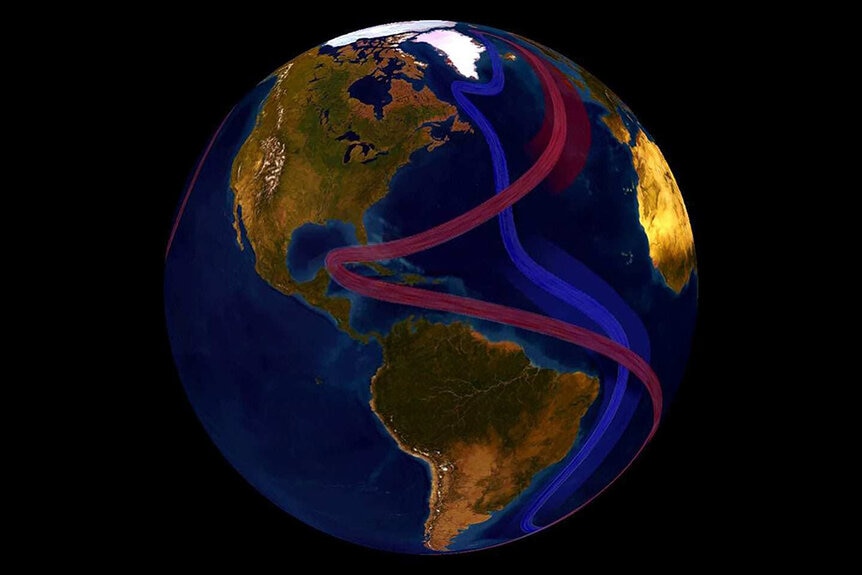Create a free profile to get unlimited access to exclusive videos, sweepstakes, and more!
Atlantic Ocean Currents Could Collapse by Mid-Century
Geologically speaking, that's practically The Day After Tomorrow.

In Roland Emmerich’s The Day After Tomorrow (streaming now on Peacock!), paleoclimatologist Jack Hall (Dennis Quaid) is gathering ice core samples when a chunk of ice the size of Rhode Island breaks away from the shelf. Hall travels to an international climate summit to present his findings, warning of an imminent climate collapse.
“The Northern Hemisphere owes its temperate climate to the North Atlantic Current,” Hall explains to the gathered scientists and dignitaries, “Heat from the Sun arrives at the equator and is carried north by the ocean. But global warming is melting the polar ice caps and disrupting this flow. Eventually, it will shut down, and when that occurs, there goes our climate.”
RELATED: Could Enceladus' Frozen Subsurface Ocean Contatin Active Currents?
Scientists in the real world have long warned that this could eventually happen, but the estimated timelines are measured in decades or centuries, causing decision makers to drag their feet doing anything about it. A recent study published in the journal Nature Communications, however, predicts Atlantic Ocean currents could collapse as early as 2025.
The Atlantic Meridional Overturning Circulation (AMOC)
The world’s oceans aren’t static bodies of water; they are swishing, undulating things which circulate around the planet, following established currents the same way your veins and arteries circulate through your body. They are quite literally the lifeblood of the planet.
Currents are created and maintained by a complex set of forces, including the movements of the Sun and the Moon, but the Atlantic Meridional Overturning Circulation (AMOC) is driven by forces closer to home. It’s part of what’s known as the global conveyor belt, responsible for circulating warm surface waters and deeper, cool water up and down the Atlantic.
It’s powered by temperature and salt gradients which naturally occur at different latitudes. As warm water drifts toward the poles, it cools, freezes, and leaves its salt behind. The leftover water, now bloated with salt, becomes denser and sinks and drifts southward again where it rises, warms, and the cycle continues.
If the AMOC were to slow down or stop altogether, it would have far-reaching implications, potentially impacting everyone on the planet. Prior assessments by the Intergovernmental Panel on Climate Change (IPCC) have suggested that AMOC is unlikely to collapse within the 21st century, while the new study contradicts that.
If the AMOC does give out, added freshwater from melting polar ice would move the rain belts, causing droughts that would impact millions or billions of people.
Meanwhile, rising sea levels would make many coastal areas unlivable, according to the National Oceanic and Atmospheric Administration (NOAA).
Predicting the Collapse of Atlantic Ocean Currents
Researchers didn’t have a lot of direct data to work with because continuous monitoring of the AMOC only began in 2004. To get a wider view, Peter Ditlevsen and Susanne Ditlevsen, from the Niels Bohr Institute and the Institute of Mathematical Sciences and the University of Copenhagen, co-authors of the study, used ocean surface temperatures in an area south of Greenland over a period of 150 years.
Their analysis and modeling of that data reveals cooling in that region between 1870 and 2020, which the study authors say can only be caused by weakening of the AMOC. Their model predicts, with 95% certainty, that the AMOC will collapse sometime between 2025 and 2095, with the most likely timeframe being mid-century.
RELATED: Our Pale Blue Dot Is Turning Green, Thanks to Climate Change
Of course, this is only one study, based on data from only one part of the ocean, and it stands in contrast to an existing body of evidence. It shows a trend but isn’t necessarily indicative of what’s going on in the AMOC today, or what might happen tomorrow (or the day after tomorrow). The authors also note that while there is high confidence in their calculation, it is only as accurate as the model itself.
“However, we have reduced the analysis to have as few and sound assumptions as possible, and given the importance of the AMOC for the climate system, we ought not to ignore such clear indicators of an imminent collapse,” the authors note.
Whether it happens in 2025 or 2225, the collapse of the AMOC would be catastrophic, but it’s something we can prevent or at least mitigate. All we must do is take targeted, collective changes to reduce our impact on the climate. It’s going to cost us, but as Dennis Quaid’s Jack Hall says, “the cost of doing nothing could be even higher.”
Glimpse our potential future in The Day After Tomorrow, streaming now on Peacock!




























